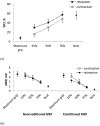Contribution of intracortical inhibition in voluntary muscle relaxation
- PMID: 22791231
- PMCID: PMC8103219
- DOI: 10.1007/s00221-012-3173-x
Contribution of intracortical inhibition in voluntary muscle relaxation
Abstract
Terminating a voluntary muscle contraction is an important aspect of motor control, and yet, its neurophysiology is unclear. The objective of this study was to determine the role of short-interval intracortical inhibition (SICI) by comparing SICIs during relaxation from a power grip versus during a sustained power grip at the matching muscle activity level. Right-handed healthy young adults gripped and relaxed from power grip following auditory cues. The relaxation period was determined as the time for the flexor digitorum superficialis (FDS) muscle to reach its pre-contraction baseline level after the cue to relax. SICI during relaxation was obtained at different times into the relaxation period in two separate studies (70, 80, 90 % into relaxation in Study 1; 25, 50, 75 % into relaxation in Study 2). In addition, SICI during sustained contraction was assessed while subjects maintained a power grip at the matching FDS EMG levels (obtained during relaxation, for both Studies). Results showed that the mean SICI was greater during relaxation than during sustained contraction at the matching muscle activity level in both Studies (p < 0.05), indicating increased activation of intracortical inhibitory circuits for muscle relaxation. SICI gradually increased from 25 to 50 and 75 % into relaxation (Study 2, p < 0.05), but did not change from 70 to 80 and 90 % into relaxation (Study 1). MEP decreased with progression of relaxation (p < 0.05) in both Studies, reflecting gradual decreases in corticomotor excitability. This work supports the hypothesis that relaxation from a voluntary muscle contraction involves inhibitory activity in the primary motor cortex.
Figures






Similar articles
-
Relaxation from a voluntary contraction is preceded by increased excitability of motor cortical inhibitory circuits.J Physiol. 2004 Jul 15;558(Pt 2):685-95. doi: 10.1113/jphysiol.2004.064774. Epub 2004 Jun 4. J Physiol. 2004. PMID: 15181164 Free PMC article.
-
Delayed grip relaxation and altered modulation of intracortical inhibition with aging.Exp Brain Res. 2016 Apr;234(4):985-95. doi: 10.1007/s00221-015-4527-y. Epub 2015 Dec 21. Exp Brain Res. 2016. PMID: 26686531 Free PMC article.
-
Modification of motor cortex excitability during muscle relaxation in motor learning.Behav Brain Res. 2016 Jan 1;296:78-84. doi: 10.1016/j.bbr.2015.09.001. Epub 2015 Sep 2. Behav Brain Res. 2016. PMID: 26341320
-
Modulation of motor cortex inhibition during motor imagery.J Neurophysiol. 2017 Apr 1;117(4):1776-1784. doi: 10.1152/jn.00549.2016. Epub 2017 Jan 25. J Neurophysiol. 2017. PMID: 28123007 Free PMC article.
-
Age-related differences in short- and long-interval intracortical inhibition in a human hand muscle.Brain Stimul. 2014 Sep-Oct;7(5):665-72. doi: 10.1016/j.brs.2014.06.014. Epub 2014 Jul 5. Brain Stimul. 2014. PMID: 25088463
Cited by
-
Shoulder position and handedness differentially affect excitability and intracortical inhibition of hand muscles.Exp Brain Res. 2021 May;239(5):1517-1530. doi: 10.1007/s00221-021-06077-w. Epub 2021 Mar 9. Exp Brain Res. 2021. PMID: 33751158 Free PMC article.
-
Brain Activity Underlying Muscle Relaxation.Front Physiol. 2019 Dec 3;10:1457. doi: 10.3389/fphys.2019.01457. eCollection 2019. Front Physiol. 2019. PMID: 31849707 Free PMC article. Review.
-
Understanding the Consequences of Repetitive Subconcussive Head Impacts in Sport: Brain Changes and Dampened Motor Control Are Seen After Boxing Practice.Front Hum Neurosci. 2019 Sep 10;13:294. doi: 10.3389/fnhum.2019.00294. eCollection 2019. Front Hum Neurosci. 2019. PMID: 31551732 Free PMC article.
-
Brain Activation During Passive and Volitional Pedaling After Stroke.Motor Control. 2019 Jan 1;23(1):52-80. doi: 10.1123/mc.2017-0059. Motor Control. 2019. PMID: 30012052 Free PMC article.
-
Motor inhibition and its contribution to recovery of dexterous hand use after stroke.Brain Commun. 2022 Sep 23;4(5):fcac241. doi: 10.1093/braincomms/fcac241. eCollection 2022. Brain Commun. 2022. PMID: 36262369 Free PMC article.
References
-
- Basmajian JV (1989) Biofeedback: Principles and Practice for Clinicians. 3rd edn. Williams & Wilkins, Baltimore
MeSH terms
Grants and funding
LinkOut - more resources
Full Text Sources

